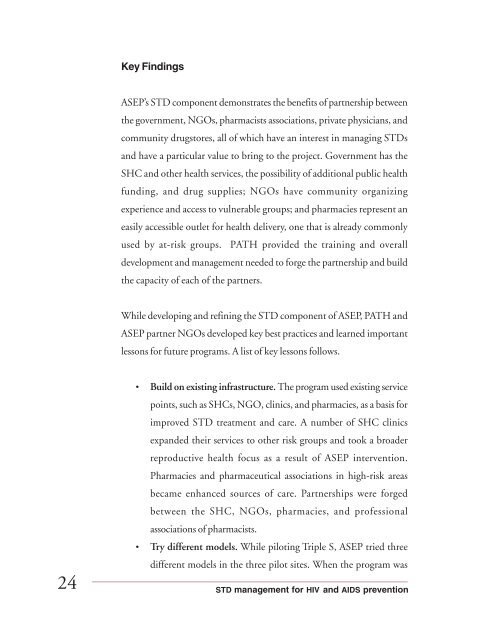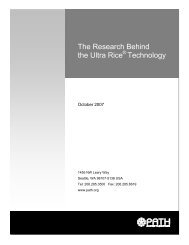STD Management for HIV and AIDS Prevention - Path
STD Management for HIV and AIDS Prevention - Path
STD Management for HIV and AIDS Prevention - Path
Create successful ePaper yourself
Turn your PDF publications into a flip-book with our unique Google optimized e-Paper software.
Key Findings<br />
ASEP’s <strong>STD</strong> component demonstrates the benefits of partnership between<br />
the government, NGOs, pharmacists associations, private physicians, <strong>and</strong><br />
community drugstores, all of which have an interest in managing <strong>STD</strong>s<br />
<strong>and</strong> have a particular value to bring to the project. Government has the<br />
SHC <strong>and</strong> other health services, the possibility of additional public health<br />
funding, <strong>and</strong> drug supplies; NGOs have community organizing<br />
experience <strong>and</strong> access to vulnerable groups; <strong>and</strong> pharmacies represent an<br />
easily accessible outlet <strong>for</strong> health delivery, one that is already commonly<br />
used by at-risk groups. PATH provided the training <strong>and</strong> overall<br />
development <strong>and</strong> management needed to <strong>for</strong>ge the partnership <strong>and</strong> build<br />
the capacity of each of the partners.<br />
While developing <strong>and</strong> refining the <strong>STD</strong> component of ASEP, PATH <strong>and</strong><br />
ASEP partner NGOs developed key best practices <strong>and</strong> learned important<br />
lessons <strong>for</strong> future programs. A list of key lessons follows.<br />
24<br />
• Build on existing infrastructure. The program used existing service<br />
points, such as SHCs, NGO, clinics, <strong>and</strong> pharmacies, as a basis <strong>for</strong><br />
improved <strong>STD</strong> treatment <strong>and</strong> care. A number of SHC clinics<br />
exp<strong>and</strong>ed their services to other risk groups <strong>and</strong> took a broader<br />
reproductive health focus as a result of ASEP intervention.<br />
Pharmacies <strong>and</strong> pharmaceutical associations in high-risk areas<br />
became enhanced sources of care. Partnerships were <strong>for</strong>ged<br />
between the SHC, NGOs, pharmacies, <strong>and</strong> professional<br />
associations of pharmacists.<br />
• Try different models. While piloting Triple S, ASEP tried three<br />
different models in the three pilot sites. When the program was<br />
<strong>STD</strong> management <strong>for</strong> <strong>HIV</strong> <strong>and</strong> <strong>AIDS</strong> prevention

















